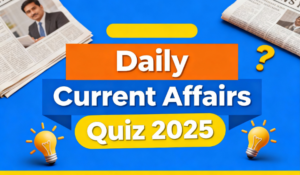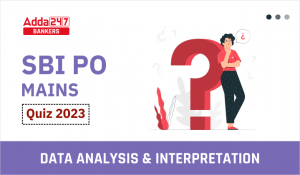Dear Aspirants,
Banking Awareness for Dena Bank PO Exam 2018
With the increased competition in the field of banking examinations, it has now become very important to cover up all the sections efficiently. One subject that can help you bagging graceful marks in the minimum time in these examinations is Banking Awareness. Banking Awareness Quiz not only helps you deal with the General Awareness Section of Banking Exams but also, the Personal Interview round of Banking Recruitment.
Q1. Which of the following do not fall within the functions of the Reserve Bank of India?
(a) Regulation of currency
(b) Control of credit
(c) Banker to the government, banker’s bank and lender of the last resort.
(d) Accepting deposits and making loans and advances to public
(e) None of the given options is true
S1. Ans.(d)
Sol. Accepting deposits and making loans and advances to public is not fall within the functions of the Reserve Bank of India.
Q2. Which of the following are the main functions of the Reserve Bank of India?
(a) Granting licenses to commercial banks for opening branches in rural areas
(b) Accepting deposits from the public
(c) Regulating foreign exchange business
(d) Acting as note issuing authority, bankers’ bank and banker to the government
(e) None of the given options is true
S2. Ans.(d)
Sol. Acting as note issuing authority, bankers’ bank and banker to the government is the main functions of the Reserve Bank of India.
Q3. The approved assets against which currency notes are issued by RBI comprise of-
(a) gold coin and bullion and rupee coin
(b) foreign securities and Government of India rupee securities of any maturity
(c) bills of exchange and promissory notes payable in India which are eligible for purchase by RBI
(d) All of the above
(e) None of the given options is true
S3. Ans.(d)
Sol. All of the above.
Q4. What is the Public Debt Office of Reserve Bank of India?
(a) is a central depository for all types of Government securities except Treasury Bills
(b) attends to the function of note issue the Reserve Bank of India
(c) is responsible for maintaining external value of the rupee
(d) controls balance of payment position of the Government of India
(e) None of the given options is true
S4. Ans.(a)
Sol. Public Debt Office of RBI is a central depository for all types of Government securities except Treasury Bills.
Q5. RBI has directed banks that the exercise of verification of asset classification and income recognition should be done as part of the audit work by the branch and statutory Auditors work by the branch and statutory Auditors effective from the year ending-
(a) 31st March 1993
(b) 31st March 1994
(c) 31st March 1995
(d) 31st March 1996
(e) 31st March 1997
S5. Ans.(b)
Sol. From 31st March 1994, RBI has directed banks that the exercise of verification of asset classification and income recognition should be done as part of the audit work by the branch and statutory Auditors work by the branch and Statutory Auditors.
Q6. Which of the following are the instruments of Credit Control in the hands of the RBI?
I. Lowering or raising the discount and interest rates.
II. Raising the minimum support price of the major agro products.
III. Lowering or raising the minimum cash reserves maintained by the commercial banks.
Select the correct answer using the codes given below.
(a) Only I
(b) Only II
(c) Only III
(d) Both I and III
(e) Both II and III
S6. Ans.(d)
Sol. Both I and III.
Q7. RBI’s open market operation transactions are carried out with a view to regulate-
(a) liquidity in the economy
(b) prices of essential commodities conflation
(c) borrowing power of the banks
(d) All of the above
(e) None of the given options is true
S7. Ans.(d)
Sol. All of the above.
Q8. The stance of RBI monetary policy is-
(a) inflation control with adequate liquidity for growth
(b) improving the credit quality of the banks
(c) strengthening credit delivery mechanism
(d) supporting investment demand in the economy
(e) All of the above
S8. Ans.(e)
Sol. All of the above
Q9. Which of the following is not a function of the RBI?
(a) Maintaining Forex
(b) Deciding Bank Rate, CRR, and SLR from time to time
(c) Opening Savings Accounts for the general public
(d) Prescribing the Capital Adequacy Ratio
(e) Currency Management
S9. Ans.(c)
Sol. Opening Savings Accounts for the general public is not a function of the RBI.
Q10. What does the letter ‘L’ denote in the term ‘LAF’ as referred to every now and then in relation to the monetary policy of the RBI?
(a) Liquidity
(b) Liability
(c) Leveraged
(d) Longitudinal
(e) Linear
S10. Ans.(a)
Sol. LAF stands for Liquidity Adjustment Facility.
Q11. Which of the following is not a measure adopted by the Government or RBI to control inflation?
(a) Monetary policy
(b) Fiscal policy
(c) Bank Rate
(d) Price control
(e) Financial inclusion
S11. Ans.(e)
Sol. Financial inclusion is where individuals and businesses have access to useful and affordable financial products and services by Banks or other Financial Institutions that meet their needs that are delivered in a responsible and sustainable way.
Q12. Whenever RBI does some Open Market Operation transactions, actually it wishes to main regulate which of the following?
(a) Inflation only
(b) Liquidity in economy
(c) Borrowing powers of the banks
(d) Flow of foreign direct investments
(e) None of the given options is true
S12. Ans.(b)
Sol. Liquidity in economy.
Q13. Interest rates on which of the following deposit schemes is fixed or deregulated by the Reserve Bank of India?
(a) Fixed deposits above 5 years’ maturity
(b) Recurring deposits
(c) Savings bank
(d) Flexi Deposit Scheme
(e) None of the given options is true
S13. Ans.(c)
Sol. Savings bank interest rate decided by RBI. But sometimes commercial bank change this interest rate.
Q14. Which of the following are decided by the Reserve Bank of India?
I. Deposit rates
II. Base Rate
III. Prime Lending Rate
Select the correct answer using the codes given below
(a) Only I
(b) Only II
(c) Only III
(d) II and III
(e) None of these
S14. Ans.(b)
Sol. Base rate is the minimum rate set by the Reserve Bank of India below which banks are not allowed to lend to its customers. Base rate is decided in order to enhance transparency in the credit market and ensure that banks pass on the lower cost of fund to their customers. Loan pricing will be done by adding base rate and a suitable spread depending on the credit risk premium.
Q15. On which rate, RBI has recently deregulated the rates of interest to be provided by various banks to their depositors/customers with on their accounts.
(a) Time deposit
(b) Saving bank
(c) Loan
(d) Fixed deposit
(e) Current
S15. Ans.(b)
Sol. On Saving bank rate, RBI has recently deregulated the rates of interest to be provided by various banks to their depositors/customers with on their accounts.






 Daily Current Affairs Quiz 2025 19 Novem...
Daily Current Affairs Quiz 2025 19 Novem...
 Quantitative Aptitude Quiz For SBI PO Ma...
Quantitative Aptitude Quiz For SBI PO Ma...
 Inequalities Basic Reasoning Quiz for Al...
Inequalities Basic Reasoning Quiz for Al...








